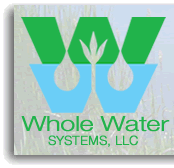FAQs -
WHOLE WATER CWB
How much space does a constructed wetland require?
Less than you would think. If you have backyard or any space for landscaping, you have space for a constructed wetland. Whole Water’s constructed wetlands are generally designed as an attractive asset to the landscaping. With creative design, they can be implemented in surprisingly compact spaces in ways that complement the architecture and/or landscaping. Subsurface flow designs create a completely dry, useable surface compatible with virtually unlimited design options.
Does it Smell?
No. Subsurface flow wetlands maintain water levels below a layer of gravel and thatch, effectively isolating and oxidizing odors preventing any odor from reaching the surface. Primary treatment tanks and pump stations are conventionally vented through building roof vents. We have commercial systems operational for over 15 years without a single odor compliant.
How much does it cost?
The first costs for a constructed wetland water treatment system are typically more than a simple dispersal field (disposal), but less than alternatives when treatment or a raised bed gravel filter are required or desired (water reuse or other environmental reasons). Significant cost benefits of constructed wetlands are typically realized when engineered designs are required at small cluster scale and larger.
Will it freeze during the winter?
No, it will not freeze! We have had wetlands installed in the most s evere cold climates of the rocky mountain high country for over 15 years and have not experienced a single freeze hindering operation. The system is designed to accommodate freeze points, and our patented in-cell level control structure eliminates “full pipe” freezing experienced in conventional weir structure designs.
Can a constructed wetland blend into the landscaping?
Yes. We can choose native wetland plants to blend into and enhance any landscaping plan, or to be a beautiful focal point of the landscape. Available wetland plants can fit seamlessly into irrigated designed landscapes, native meadow grasses, flowers or bushes. Designs can be made to emulate natural landscapes, highly designed modern contexts, or can be mowed to resemble a traditional lawn setting.
Can the treated water be reused?
It is possible to use the treated water for sub-surface irrigation of lawn or other landscape plants, non-root crop vegetables or even for grey water uses inside the house, i.e. toilet flushing.
How clean is the water that comes out of the wetland?
When laboratory tested, our treated water routinely exceeds quality standards set for the vast majority of modern municipal treatment plants – without chemical or expensive energy inputs.
Will the wetland interact with rainwater and surrounding surface water?
Unless located inside a greenhouse, the wetland cell treating sewage receives any water which falls upon it without adversely affecting its treatment performance. The cell is hydraulically isolated from any predictable runoff from the surrounding surfaces. Normally, the treated water is discharged into the ground, and does not come into contact with surface water. However, with appropriate design and permitting provisions, it may be discharged into surface waters.
|


